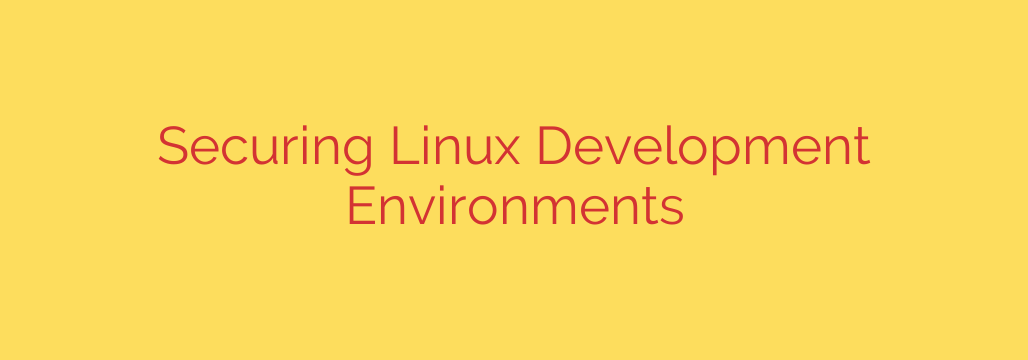
How to Secure Your Linux Development Environment: A Comprehensive Guide
Your Linux development environment is more than just a place to write code—it’s a vault containing source code, API keys, credentials, and access to sensitive infrastructure. A breach here can be catastrophic, not just for you but for your entire organization. Treating your local machine with the same security rigor as a production server is no longer optional; it’s essential.
This guide provides actionable steps to harden your Linux development environment, transforming it from a potential liability into a secure and resilient workstation.
The Foundation: Secure System Setup
Security starts the moment you install your operating system. Building on a weak foundation will undermine all your future efforts.
Start with Full Disk Encryption (FDE)
Physical theft is a real threat. If your laptop is stolen, full disk encryption is your last and most powerful line of defense. It ensures that without your decryption key or password, the data on your drive is nothing more than unreadable gibberish.
Actionable Tip: Always enable Full Disk Encryption (FDE) during the Linux installation process. Most modern installers for distributions like Ubuntu, Fedora, and Arch Linux offer this as a standard option. Don’t skip it.
Enforce Strong User Account Policies
Your user account is the gateway to your system. Avoid the common pitfall of performing daily tasks as the root user. Operating under a non-privileged account drastically limits the potential damage from a malicious script or a compromised application.
Actionable Tip: Create a strong, unique password for your user account and lock the root account’s password to prevent direct logins. Use sudo for administrative tasks, which provides a clear audit trail and requires you to consciously escalate your privileges.
System Hardening Essentials
Once your system is installed, the next step is to reduce its attack surface. A default installation is often configured for convenience, not maximum security.
Keep Your System and Software Updated
Vulnerabilities are discovered in software all the time. The single most effective security measure you can take is to keep your system and all installed packages up to date. These updates contain critical security patches that protect you from known exploits.
Actionable Tip: Run system updates regularly. Get into the habit of running sudo apt update && sudo apt upgrade (for Debian/Ubuntu) or sudo dnf upgrade (for Fedora/CentOS) at least once a week.
Configure a Firewall
A firewall controls incoming and outgoing network traffic, acting as a critical barrier between your machine and the internet. It can block unauthorized access attempts and prevent malicious software from communicating with its command-and-control servers.
Actionable Tip: Linux has powerful built-in firewall capabilities. Use a simple tool like UFW (Uncomplicated Firewall) to configure it. A good starting point is to deny all incoming connections by default and only allow the ones you specifically need (like SSH).
sudo ufw enable
sudo ufw default deny incoming
sudo ufw allow ssh
Secure Your SSH Access
If you access your development machine remotely or use SSH to connect to other systems, securing this service is paramount.
Actionable Tip: Disable password-based authentication for SSH and use key-based authentication instead. SSH keys are significantly more secure and resistant to brute-force attacks. Additionally, consider disabling root login over SSH entirely in your sshd_config file (PermitRootLogin no).
Securing Your Development Workflow
A hardened system is only half the battle. Your daily development practices must also be secure.
Isolate Projects with Containers and Virtual Environments
Dependencies for one project can sometimes conflict with or create vulnerabilities in another. Using isolation tools prevents this cross-contamination and contains potential security issues to a single project.
Actionable Tip: Use containers (like Docker or Podman) to isolate project environments and their dependencies. For language-specific projects, leverage built-in tools like Python’s venv or Node’s nvm to manage package versions and keep your global system clean.
Master Secret Management: Never Hardcode Credentials
Hardcoding API keys, passwords, or tokens directly into your source code is one of the most common and dangerous security mistakes. If your code is ever leaked or shared, those secrets are exposed.
Actionable Tip: Store secrets in environment variables or use a dedicated secrets management tool like HashiCorp Vault or a cloud provider’s secret manager. Add configuration files containing secrets (like .env files) to your .gitignore to ensure they are never committed to your repository.
Implement Secure Git Practices
Your version control system is a record of your work and a potential attack vector.
Actionable Tip: Sign your Git commits with a GPG key. This verifies that the commits genuinely came from you and have not been tampered with. This is crucial for maintaining the integrity of your codebase, especially in collaborative projects.
By integrating these practices into your routine, you can significantly enhance the security posture of your Linux development environment. Security isn’t a one-time setup; it’s an ongoing process of vigilance and good habits that protects your most valuable digital assets.
Source: https://www.unixmen.com/essential-linux-security-hardening-for-development-environments/








